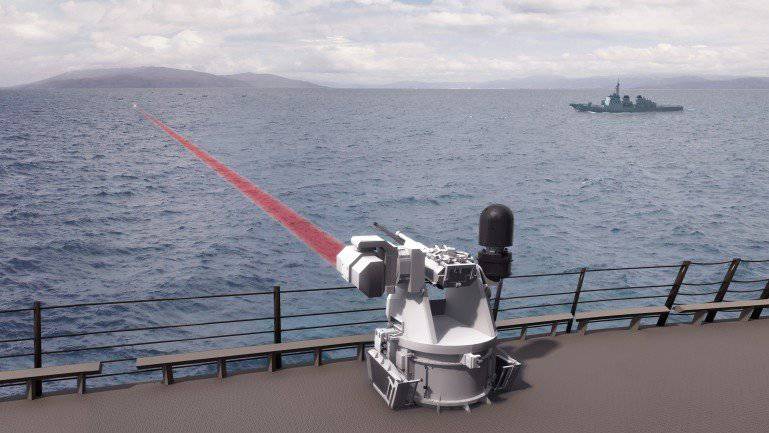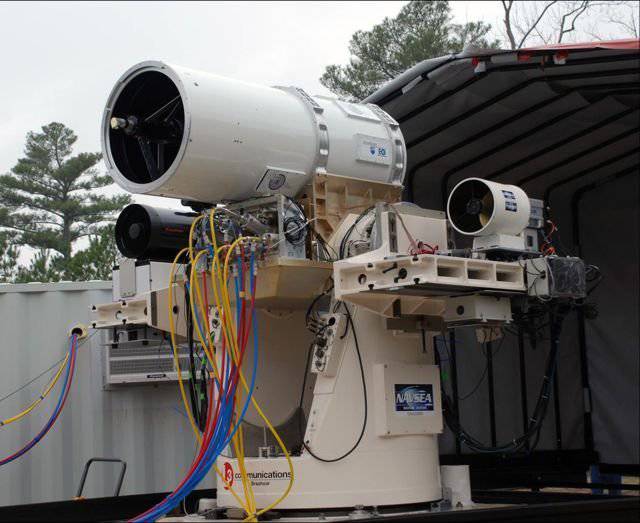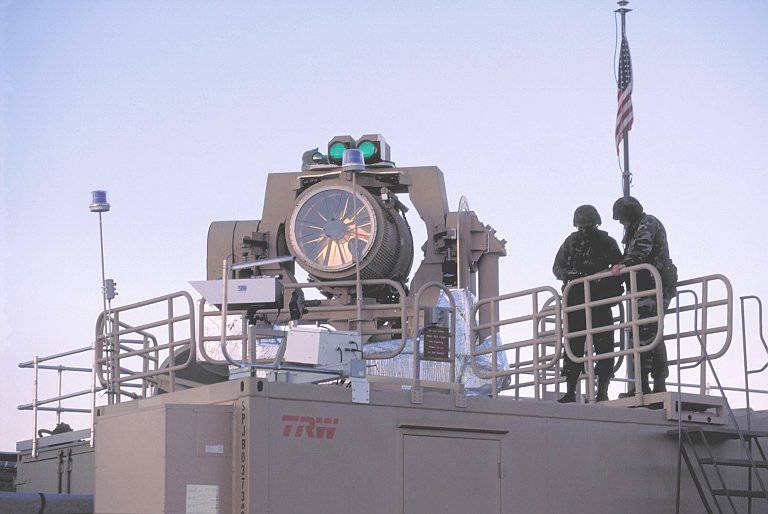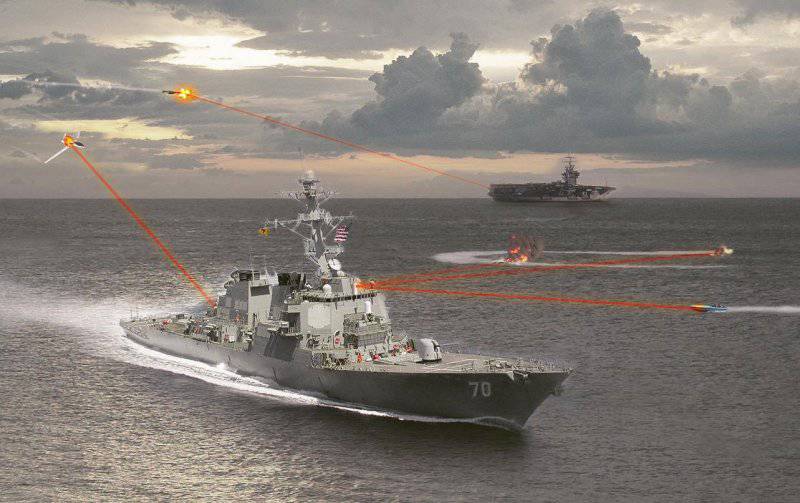Laser for US NAVY
The first laboratory samples of lasers did not appear yet, as military departments began to show special interest in them. It is not known what exactly caused it: whether numerous science fiction works, where the ray weapon Traditionally, it has extraordinary power and efficiency, or a simple pragmatic calculation. Moreover, the second version looks a little more real, because even now, half a century later, it takes some time for an attack of a sufficiently distant target. For example, an anti-aircraft missile, flying at a speed three times greater than the speed of sound, and having a range of 150 km, will fly to a maximum interception line of about two minutes. The laser beam, in turn, will reach the target at the same distance in an insignificant fraction of a second. True, for defeat he will need the appropriate power and some time, during which the target will be heated for its destruction. Another advantage of a laser over an anti-aircraft missile lies in the fact that most of the latter have a radar head of various types of guidance, and, therefore, may not reach the target if it uses means of EW. Finally, due to the lack of “expendable material” in the form of rather expensive rockets, the cost of operating a laser system may be somewhat cheaper than the traditional air defense system.
Most likely, American researchers, who have been working on various options for using lasers in combat since the end of 60's, came to such conclusions. At the beginning of the next decade, the ASMD program (Anti-Ship Missile Defense - protection against anti-ship missiles) was launched in the States. The ships were the bearer of the promising weapons: firstly, at that time a large number of new anti-ship missiles appeared, capable, if not destroying, then severely damaging any ship, and secondly, of all classes of self-propelled equipment, surface ships could transport a laser machine, with appropriate weight. The work on ASMD was divided into three main areas: the detection and recognition of targets, the formation of a beam of sufficient power and pointing the beam at the target.
With the first point, everything was relatively clear - the appropriate technologies have already been applied and developed. With the type of laser for a long time did not bother. By that time there were not so many of them, so they chose the newest and most promising, namely, gas-dynamic, using carbon dioxide as the active medium. It should be noted that scientists from other countries - Great Britain, France and Germany - made the same choice. The precision beam targeting system was assigned to Hughes Aircraft, and the main contractor for the project was TRW, which had by that time the greatest experience in the laser business.
Soon after the start of the active phase of work at TRW, they abandoned the carbon dioxide laser - it, of course, met a number of requirements, but on the whole did not suit the developer. A continuous new chemical has become a fluoro-deuterium mixture as a “fuel”. This system was called NACL (Navy ARPA Chemical Laser - Marine Chemical Laser commissioned by the ARPA agency). The first prototype of the new laser produced radiation with a power up to 100 kW, which at that time was quite a lot. NACL was installed on the Hughes guidance system and the entire installation went to the TRW Californian test site. There, up to 1976, work continued on fine-tuning all systems.

In the summer of 76-th work at the site of the TRW had to stop. We must rejoice the reader - this was not due to the closure of the project. In the middle of the year, the Pentagon decided that it was not worth scattering work across several enterprises and landfills. Therefore, a single center for HELSTF (High Energy Laser System Test Facility) laser work was established at the White Sands test site in New Mexico. And next year, having become convinced of the prospects of the ASMD project, it was “reborn” into the Sea Light program (“Sea Light”). Now, the military department required to create a laser capable of producing a beam up to 2 MW for a certain time and to test the entire system in conditions close to real. Plain text in the technical specifications said about the interception of anti-ship missiles, including cruise missiles.
TWR brilliantly coped with the task, and in September 1980 of the year began ground testing of the MIRACL emitter system (Mid-InfraRed Advanced Chemical Laser - Promising chemical laser operating in the mid-wave IR spectrum. The acronym name at the same time sounds like the English word “miracle”). This very “Miracle” on tests gave out radiation with a wavelength of 3,8 μm and power up to 2,2 MW, which was 22 times as large as the first lasers created by the ASMD program. Like the NACL, the new laser worked on a fluoro-deuterium mixture.
Testing and refinement of the MIRACL continued with varying success until 1983, when US President R. Reagan announced the launch of the so-called Strategic Defense Initiative. Then the Sea Light program was transferred to the management of SDI. Despite the orientation of SOI to counteract strategic missiles, work on laser systems was still carried out to fleet. Moreover, in the 84th, MIRACL was combined with the new radiation formation system SLBD (Sea Light Beam Director). Over the next three years, the complex was brought to mind; sometimes there is information that several training missiles were shot down with its help. How true this is is not exactly known, but in light of the financial and time costs of the project, the successful interception of missiles at that time already seems quite real.

The first reliable information about the combat training application of the laser interception system refers to the 1989 year. Then the MIRACL + SLBD bundle first “fired” at the BQM-34 subsonic radio-controlled missile targets, and then the Vandal missiles were made targets. The latter simulated CRP, flying at a speed of about M = 2 at low altitudes. Prior to 1992, inclusive, several dozen training interceptions were conducted, during which the system’s weaknesses were revealed and possible ways of its application were tested. The result of the test was the Pentagon’s order to develop a ship-based laser installation. Naturally, while no one was going to launch a combat laser in the series, but it was necessary to check the possibility of placing it on ships.
According to the technical assignment of the second half of 93, the laser had to continuously output power of at least 2 MW for some time, not interfere with other systems of the ship, operate at temperatures from -45 to + 55 degrees and air humidity from zero to 95%. After consulting with the developer, the dimensions of the laser system were established: they should have been equal to the size of the standard shipboard 127-mm artillery Mk45. In the course of work on the ship laser, it will even become clear that it can be by 15-20 percent lighter than the Mk45. During the development of the shipboard system, MIRACL + SLBD removed most of the control and diagnostic equipment, which was needed only for testing. At the same time changed the emission system of spent reagents. First, its diffuser was placed above the optical system (now the reagents were ejected vertically upwards, which did not cause reactive moments that interfered with the guidance system), and secondly, it was proposed to use low-power turbojet engines to create sufficient pressure. As a result, the release of waste reagents did not create problems for guidance systems and did not interfere with the crew, since a cloud of chemicals rose above the superstructure of most ships under pressure.
The finished ship installation with the same dimensions as the Mk45, has a supply of reagents for operation during 100 seconds, which, depending on the distance to the target, is enough for 30-90 "volleys". For a two-fold increase in "ammunition" (with two-second "shots"), the designers say, it is required to increase the installation weight by only 16%, and the volume by 6%. Regardless of the supply of reagents, the power consumption of the system is 130 kW • h in standby mode and 390 kW • h in combat mode, which is quite within the power of most American ship electrical systems. Separately, the developers of the system note the fact that most of the exhausts of the laser system are inert gases. According to them, laser weapons are environmentally safer than traditional rocket. The system contains high-pressure gas cylinders in which reagents are stored. In order to avoid an explosion of cylinders in an emergency situation, they have a vapor system for quick pressure relief. The control of laser weapons is fully integrated into the ship's MSA: all information about the operation of the laser setup is displayed at the command center of the ship, and is controlled from there.
It should be noted that since the beginning of the 2000-s many other companies have joined the work on laser weapons. For example, in 2006, Raytheon demonstrated a fiber laser with a total power of 20 kW. Nevertheless, this was enough to “burn” a mortar mine for half a kilometer.

Raytheon offered to use their installation as a tactical laser weapon, including for the ground forces. Interestingly, a ready-made stabilized platform was used for the low-power laser - it was "borrowed" from the Mk15 anti-aircraft artillery mount. In 2009, the same Raytheon began testing a new laser - the Laser Centurion Demonstrator, now it was a solid-state emitter. With a relatively low power, the LCD is much more convenient to use, because does not require storage of chemicals and is powered from the mains supply of the carrier. Another feature of this complex is the guidance system. This time Raytheon took from the Mk15 not only the platform and mechanics, but also the electronics responsible for aiming and controlling the fire. After a number of modifications, taking into account the speed of the beam "projectile", the LCD showed itself in all its glory. The following year, a new 50-kilowatt solid-state laser DE & EWS (Directed Energy and Electric Weapon Systems), again on mechanics from the Mk15, shot down four targets in one go. In 2011, there were several reports that Raytheon tested another ship's solid-state laser off the California coast, and again four targets were shot down, flying at a speed of about 300 km / h. The average range was two miles. Representatives of the US Navy highly appreciated the new laser system for ships and noted that in the future it could become the standard armament of the naval air defense.
In the second half of the 2000-x ship lasers were engaged at Northrop Grumman. The Bureau of Naval Studies commissioned them with a MLD project (Maritime Laser Demonstration - Maritime Laser Demonstrator). The results of the work of the company were tests that took place in the spring of 2011 of the year: in the Pacific Ocean, a ship with a HEL pilot plant, equipped with a JHPSSL laser on 15 kW, successfully destroyed a small motor boat. Representatives of "Northrop" separately note that the installation of a laser on the ship did not affect the characteristics of the latter. In addition, several relatively low-power emitters can be connected to the laser machine without any special problems, thanks to which the total power of the beam sent to the target will increase to 100 kW and more.
From the middle of 2011 onwards, Boeing and BAE Systems have been working together on a sea-based tactical system Mk38 Mod2 or TLS (Tactical Laser System) with a radiation power of about 10 kW. It is made on the basis of the Mk38 serial gun mounts and is intended for the destruction of small surface objects and aircraft at short range. At the moment, the developers declare a rate of fire to 180 pulses per minute and a range of the order of 2-3 kilometers. They do not exclude the possibility of creating a hybrid artillery-laser installation.
Considering the current state of affairs with American projects of combat lasers, it can be concluded that US scientists and designers have almost reached the stage when it will be possible to equip warships with such weapons in series. As for other laser systems such as aviation, then you have to wait here - this technique is much more sensitive to the weight of the equipment that is placed on them. Of course, it is not the first year that work has been going on on the domestic A-60 project (a number of sources spoke of its renewal in 2010) and the American Boeing YAL-1, but they are still too far from mass production and practical application. So, in the next few years or even decades, the only combat laser weapons will be exclusively naval systems.

Information